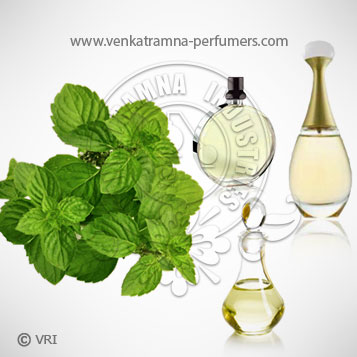
| Botanical Name | Mentha spicata |
| Common Name | Common or garden spearmint; spire, green, lamb, pea and fish mint. |
| Country of Origin | USA, Asia, Britain |
| Solubility | Insoluble in water, soluble in alcohol and oils |
| Specific Gravity | 0.971 @ 72°F |
| Optical Rotation | -47 |
| Refrective Index | 1.540 @ 72°F |
| PlantPart | Leaves |
| Bland With | Basil, eucalyptus, jasmine, lavender and rosemary. |
| CAS No | 8008-79-5 |
| Flash Point | 79 °C |
| Extraction Method | Steam Distilled |
The Spearmint oil is prepared from the extracts of the hardy perennial herb that is a native of the Mediterranean region. Spearmint has been used throughout the ages because of its medicinal value. The Greeks used it to scent their bath water. It was also considered a cure for sexually transmitted diseases like gonorrhea. It was used as far back as in the medieval times, when it was used to heal sore gums and whiten teeth.
Few herbs produce as many variants as the mint family and each tastes, smells and acts a little bit different. Spearmint is delightful, much less harsh and pungent than the more commonly used Peppermint. This is due to the fact that it contains very little menthol. Spearmint has thus been more frequently used for culinary purposes rather than medicinal ones. However, that does not mean to suggest that it has no therapeutic uses. The ancients valued it highly as a herb for students and scholars. They thought a head wreath of Spearmint a fitting crown for academics and poets, to help them concentrate and keep a clear head. The Romans liked it as a strewing herb to scent the air with a nice, fresh aroma. Spearmint is also much better for cosmetic use than the more pungent peppermint. It is very refreshing, relaxing and uplifting, for example in a bath, where Peppermint would make one feel freezing, even if the water was hot. Spearmint is not as stimulating as Peppermint, which makes it also suitable for use at night. In fact, it is said to bring happy dreams and a restful sleep
Color : Pale Yellow with Strong, Astringent Lemon odor,
Aroma : Spearmint Essential Oil has a fresh minty smell reminiscent of Peppermint. The major difference is that Spearmint oil is sweeter, and not quite as harsh.
a-pinene, b-pinene, caryophyllene, carvone, 1,8-cineole, limonene, linalool, menthol (0.5% compared to the 40% in peppermint) and myrcene.
The Spearmint Oil is very widely used in the field of medicine because of its various preventive as well as curative properties. It is very effective in the case of digestive problems as well as in cases relating to unease in the respiratory tract. Moreover, it is the complete answer to skincare, along with being the perfect cure for migraine, strain, fatigue and stress.